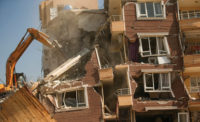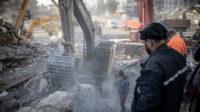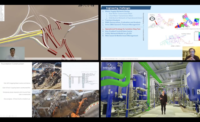Nearly two weeks after a pair of severe earthquakes rocked central Turkey and northern Syria, the full extent of damage to buildings and other structures is beginning to emerge. With the magnitude 7.8 and 7.5 epicenters located hundreds of kilometers apart, the area affected is vast.
The official death toll for the Feb 6. quakes has passed 46,000, with more than 40,000 dead in Turkey and more than 5,000 dead in Syria. The region also has a post-quake housing crisis, with Reuters reporting that at least 345,000 apartments are known to have been destroyed. By some estimates, up to two million people lost homes or were forced to evacuate.
While there are signs that poorly enforced building codes and subpar construction contributed to the poor performance of some recent construction in the quakes, there also are other factors at work, such as geology and settlement patterns, as seen in the extent of the damage.
"Some of the cities have been more than 50% or more completely destroyed," says Kit Miyamoto, founder of structural engineering firm and disaster-response investigator Miyamoto International. "Places like Hatay, are [built] on a soft riverbed [geology]. Certain areas of the city look like a nuclear blast, like pictures from Hiroshima."
In comparison, other cities in central Turkey, such as Gaziantep which is located on a mountainside, survived the quakes with relatively moderate damage and fewer collapsed buildings.
Miyamoto has been in Turkey for the past week, traveling across the quake-hit region with engineers from his firm's Istanbul office. In performing some initial assessments of structural damage for the World Bank and other NGOs, Miyamoto says the full scale of the damage is more than just visibly collapsed buildings. "Right now there's around 15,000 buildings known to have collapsed," he says. But by his calculations based on figures from other post-earthquake efforts, he expects there will be somewhere in the range of 100,000 to 150,000 buildings that sustained some kind of damage due to the quakes, and tens of thousands of those will eventually need to be demolished.
"This is the biggest disaster I've seen," says Miyamoto. "It's something that's comparable to the 2011 tsunami that wiped out whole coastal cities in Japan."
While the Turkish government has moved relatively quickly to provide emergency aid and have major roads and airports in operation, there is the larger issue of the significant damage to the privately owned building stock. That's where the recovery can drag on, says Miyamoto. "As far as the [Turkish] government's response, it's the best practice I've seen in a long time," he says. "But reconstruction will be hard."
In his tour of the earthquake zone, Miyamoto noted that some buildings built with modern seismic designs performed very well. As ENR has reported previously, some hospitals in Turkey built with modern base-isolation seismic elements fared better than surrounding structures. "[There are] about a dozen new hospitals here designed using base isolation and they not only survived the earthquake, but are completely functional," says Miyamoto.
Hospitals staying in operation through an earthquake without damage to equipment or capabilities is huge, he adds: "The value of base isolation is proven by this earthquake."
Strong Codes, Lax Enforcement
While Turkey has had modern seismic standards on the books for decades, there is a history of uneven enforcement. The sign-off and inspection processes for buildings in Turkey can be spotty, and it is in these gaps that new buildings with subpar work are built.
The Turkish government announced Feb. 12 that it was detaining 130 people it alleges were involved in substandard construction that resulted in building collapses due to the quakes. State-owned media group Anadolu Agency reported that those detained included contractors who had made improper structural modifications to buildings during renovations as well as those involved in new construction.
The fallout from the poor performance of recent construction in the quake has also touched off a political scandal for Turkish President Recep Tayyip Erdoğan. Old videos from campaign stops in the run-up to the March 2019 election have circulated on social media, showing Erdoğan bragging about the scale of residential construction in many of the cities hardest hit by the earthquakes. Specifically, Erdoğan appears to credit a zoning “amnesty” program that allowed developers and contractors to sidestep some building codes to accelerate construction schedules. Those granted the amnesty would pay a fine to circumvent some codes.
In one widely seen video clip from a campaign stop in Kahramanmaraş, a city in central Turkey particularly hard hit by the recent quakes, Erdoğan can be heard saying “We have solved the problems of 144,556 Maras citizens with the amnesty,” referring to the city’s recent building boom.
The full extent of these kinds of exemptions is not fully known at this time.
Pelin Pınar Giritlioğlu, Istanbul-based head of the Union of Chambers of Turkish Engineers and Architects’ Chamber of City Planners, told Turkish media organization Halk TV that 70,000 to 75,000 buildings in the earthquake-hit region of southern Turkey have been granted exemptions from building code standards. BBC Turkish reported in 2020 following an earthquake in the western city of Izmir that the Turkish Environment and Urbanization Ministry estimated roughly half of the buildings in Turkey were constructed in violation of regulations.
Across the border in Syria, the situation is desperate. In a region that has seen normal society upended by years of civil war, the earthquakes have inflicted a great amount of damage in a region already struggling to meet basic needs. Much of the area of northern Syria hardest hit by the quakes is under the control of rebel groups that have been fighting the Syrian government for over a decade.
CBS News reported that the UN confirmed Feb. 14 that the first of its aid convoys entered northwestern Syria. This follows a decision by Syrian President Bashar al-Assad on Feb. 13 to open two border posts to allow aid from Turkey. While the extent of the damage to buildings is considerable, there are greater concerns that a lack of equipment and supplies may add to the human toll in the region.






Post a comment to this article
Report Abusive Comment